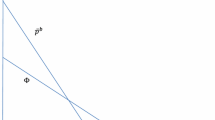Abstract
We show that an ad valorem tax is better than an equal-revenue unit tax when consumers spend some fixed proportion of income on taxed goods, when firms use constant mark-up pricing, and entry and exit drive per-firm profit to zero. These key assumptions implies that ad valorem taxes are superior in oligopoly as well as monopolistic competition, showing that earlier results on taxes in monopolistic competition (Schröder in J Econ 83(3):281–292, 2004) are not due to the mode of competition, but rather are due to the functional forms used.
Similar content being viewed by others
Notes
It must be stressed that Schröder (2004) suggests analysing unit versus ad valorem taxes with other specifications of the Dixit–Stiglitz model. The present note makes it clear why this is worthwhile, in particular since the model is used in subsequent papers, cf. note 2.
Subsequent use of the standard Dixit–Stiglitz model on unit versus ad valorem taxes with heterogeneous firms (Schröder and Sørensen 2010) and on corrective taxes (Droge and Schröder 2009) also relies on constant mark-up pricing. Reinhorn (2012) discusses optimal corrective taxation in multi-sector monopolistic competition without making assumptions about constant mark-up pricing but does not address the question of tool ranking.
The following description is brief. It follows Schröder (2004) and the reader is referred hereto for details.
A number of subsequent analyses confirm that ad valorem taxes are better than unit taxes in oligopoly. Related most closely to our note is a result due by Hamilton (2009) He shows that unit taxes are preferable in the non-normal case of decreasing preference for variety (variety matters less when output increases). In the standard Dixit–Stiglitz model preferences for variety is constant.
For a discussion of monopolistic competition models allowing some firm positive profits see Benassy (1991, Sect. 5.6).
To work out the full consequences of changes in the tax policy we have to take into account the effect on the number of firms also. This is beyond the scope of the present note. Notice that Anderson et al. (2001b) show that unit taxes can be welfare superior to unit taxes in differentiated oligopoly with free entry.
References
Anderson SP, de Palma A, Kreider B (2001a) Tax incidence in differentiated product oligopoly. J Public Econ 81(2):173–192
Anderson SP, de Palma A, Kreider B (2001b) The efficiency of indirect taxes under imperfect competition. J Public Econ 81(2):231–251
Benassy J-P (1991) Monopolistic competition. In: Hildenbrand W, Sonnenschein H (eds) Handbook of mathematical economics, vol IV. Elsevier, Amsterdam
Delipalla S, Keen M (1992) The comparison between ad-valorem and specific taxation under imperfect competition. J Public Econ 49(3):351–367
Dixit AK, Stiglitz JE (1977) Monopolistic competition and optimum product diversity. Am Econ Rev 67(3):297–308
Droge S, Schröder PJH (2009) The welfare comparison of corrective ad valorem and unit taxes under monopolistic competition. Int Tax Public Finance 16(2):164–175
Goldstein JP (1986) Mark-up pricing over the business cycle: the microfoundations of the variable mark-up. Southern Econ J 53(1):233–246
Hamilton SF (2009) Excise taxes with multiproduct transactions. Am Econ Rev 99(1):458–471
Reinhorn LJ (2012) Optimal taxation with monopolistic competition. Int Tax Public Finance 19(2):216–236
Schröder PJH (2004) The comparison between ad valorem and unit taxes under monopolistic competition. J Econ 83(3):281–292
Schröder PJH, Sørensen A (2010) Ad valorem versus unit taxes: monopolistic competition, heterogeneous firms, and intra-industry reallocations. J Econ 101(3):247–265
Spence M (1976) Product selection, fixed costs, and monopolistic competition. Rev Econ Stud 43:217–235
Stern NH (1987) The effects of taxation price control and government contract in oligopoly and monopolistic competition. J Public Econ 32:133–159
Suits DB, Musgrave RA (1953) Ad valorem and unit taxes compared. Q J Econ 67:598–604
Author information
Authors and Affiliations
Corresponding author
Rights and permissions
About this article
Cite this article
Vetter, H. Consumption taxes in monopolistic competition: a comment. J Econ 110, 287–295 (2013). https://doi.org/10.1007/s00712-012-0320-6
Received:
Accepted:
Published:
Issue Date:
DOI: https://doi.org/10.1007/s00712-012-0320-6




